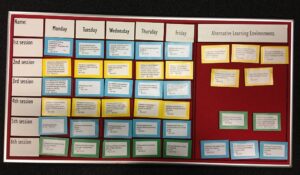Program Planning
In developing instruction for any child we follow this sequence:
- Observe and assess
- Set goals
- Plan and carry out instructional activities to work on goals
- Take data
- Revise goals and instructional strategies as needed
- Repeat steps 1-5

Planning a full-day’s programming for a child using an Active Learning approach may seem challenging. But actually, most any activity can be adapted for Active Learning. Start with the activities that the child is currently experiencing in the classroom or at home. Create a schedule of these events and evaluate them to see if the child is active and engaged in all activities and environments. Consider whether or not the child is working on his/her IEP goals in each of these activities. Observe and/or video the child in these situations so the team can consider how to adapt or enrich the activity to achieve maximum engagement from the child and to focus on specific IEP goals.
Questions to Ask
Here are some questions your team should ask:
- Does the environment need to be altered to reduce distractions, make the child aware of the materials, and arouse curiosity? What needs to change?
- Do the materials used in the activity engage the child’s sensory channels in a positive and motivating way? What needs to change?
- Does each activity focus on the child’s IEP goals and allow the team to be able to take data on the child’s progress? What needs to change?
- If the activity involves interaction with peers or adults, what educational treatments are currently being used and are they effective? What needs to change?
- If the activity is an independent play activity, do the adults allow the child to play without interruption and prompts? What needs to change?
After evaluating the current schedule of activities, identify times when the child needs more stimulation. Many times we see children with significant challenges spending a lot of time asleep or fussing during the school day. Our first thought is that they are tired or not feeling well. In fact, many times the child is just bored or not motivated by the activities that are offered. Remember if our expectations are for the child to be in Stage 2 of the Dynamic Learning Circle – Curious and Active, we have to provide activities and learning environments to encourage this activity.
The activities and environments should be focused on opportunities for the child to practice current skills and also begin to attempt slightly higher level skills. Not all activities will focus on every skill’s objective you have for the child, but many allow for working on multiple skills in one activity.
Build a Schedule
At first, you may identify only one or two activities to add into or replace existing activities in the child’s current schedule. As you observe the child and take data you will probably see opportunities to further modify the child’s daily schedule, learning environments and activities. This is a process of diagnostic teaching. We urge you to use video to record the child’s activity so the whole team can share feedback and brainstorm changes that need to be made. Remember to make changes in small increments so the child is not totally thrown off by the novelty.
A good program requires a team effort. All staff members must be willing to adjust as needed to make the program work for the child. Let the data from your observations guide your team.
When building a daily schedule for the child try to alternate fine and gross motor activities or combine gross and fine motor activities throughout the day. Be sure to include at least 45 minutes daily of adult-child interactions to address social and emotional development. The 45 minutes can be broken into multiple segments throughout the day and might include activities that include peers if the child is able to interact with them comfortably.
Try keeping each activity occurring in the same location. For example, don’t randomly do hygiene activities in a space where you play on the Resonance Board. Having centers that define various types of play may be helpful, such as a sensory center, kitchen center, music center, and so forth.
Offering a familiar object associated with the activity before you start can also let the child know what is about to happen. This is called an object symbol. If possible, pick the object that is highly preferred or always a part of the activity such as a spoon to eat with or a cup for drinking. You can signal the end of the activity by putting this object away in a “finished” box. Some child maybe able to help collect and return materials for activities if they are able to work at Phase 4 Sharing the Work or Phase 5 Experiencing Consequences. Children at younger developmental ages (less than 24 months) may not be ready to do this. Give the child a consistent name for the object symbol and activity when you offer it. If the child pushes it away or rejects it, you may want to pick another activity that focuses on similar motor skills and try that one at another time. That is why Dr. Nielsen had a space for alternative activities in her FIELA curriculum board. This gives you a time to focus on choice-making and is also a way to begin to build communication.
